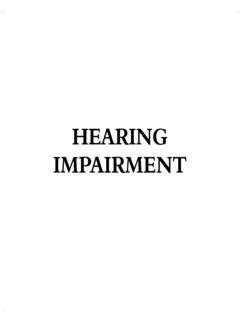Transcription of CEREBRAL PALSY - Rehabilitation Council of India
1 CEREBRAL PALSY39 William Little, a British surgeon, firstidentified CEREBRAL PALSY then called CEREBRAL Paralysis . He raised the possibility ofbirth asphyxia as a chief cause of the Freud, in 1897, suggested thatdifficult birth was not the only cause but ratheronly a symptom of other effects on fetaldevelopment. Research in modern times hasshown that 75% of the cases were not due to birthasphyxia. This supported Freud s view, eventhough through the 19th and 20th Century, Little sview was the traditional India , services to the CEREBRAL PALSY ( )population, historically has depended on theinitiatives of parents, mostly hospital based whichwere evidently at best partial fragmentary andgrossly inadequate.
2 The first special school forCerebral PALSY ( ) was set up in 1973. It wasfollowed rapidly by several schools being openedin Kolkata, Bangalore, Chennai and New Society of Northern India in 1977, SpasticsSociety of Karnataka in 1980, Spastics Society ofTamil Nadu in 1980 and Spastics Society of IndiaChapter 1 Historical Perspective(Chennai) now Vidyasagar in 1985 have Society of India , Mumbai, as acatalyst, started training of teachers and therapistsand skills development. Inclusive education hasreceived a great deal of active propagation with theestablishment of a National Resource Centre forInclusive Education at Bandra, Mumbai. Similarly,the Spastics Societies located in the Eastern,Southern and Northern regions have been veryactive in training, in providing technical supportand Spastics Society of Karnataka hasestablished facilities for early diagnosis, appropriateintervention, special education, with a NationalOpen School facility.
3 It also runs a vocationalpolytechnic and ongoing training programme inall these areas. It is a nodal Centre for NationalTrust. The community based programmes, bothrural and urban, run by the Spastics Society ofKarnataka, have a wide and effective ideology is effective inclusion in thetime frame of about 2-3 of disorders caused by injury to the developing brain in children result in what iscollectively defined as Developmentaldisabilities . It affects a very large number ofchildren in India . The condition has far reachingconsequences to the individual, family, and thecommunity in the spheres of socio-economic,emotional and quality of life to large number ofthe affected population is indeed serious.
4 Includedamong the developmental disabilities are: MentalRetardation, CEREBRAL PALSY ( ),Communication Disorders, Learning Disability,Attention Deficit Hyperactive Disorder andChildhood Autism. These may occur singly or incombination as multiple disabilities. At aconservative estimate, these disabilities account fornearly 15% of the child population (1 in 6).Against this background, CEREBRAL PALSY hasto be viewed in terms of its incidence, etiology,clinical definition, diagnosis, therapeutic andassociated interventions. Long term care,programmes for mainstreaming with vocationaland educational inputs, and well researched andmeaningful approaches to prevention also PALSY includes a group of conditionsthat are characterized by chronic disorders ofmovement or posture.
5 The site of lesion is withcortical site of lesion, its onset is early in life. It isnot the outcome of a progressive disease. Thecondition often is accompanied by seizuredisorders, sensory impairment and cognitiveChapter 2 Incidence and Magnitude of the Problemlimitations. Both in its causation and manifestation, CEREBRAL PALSY is a heterogeneous condition. A staticencephalopathy, CEREBRAL PALSY excludes allprogressive neurological disorders. Associatedneurological deficits add to the disability causedby motor of is in the range of per 1000 live births. While exact figures areunavailable in India , it can be safely estimated thatthe cumulative figures for living population at anygiven point may be PALSY is a condition with multipleetiologies in the antenatal, natal and in the postnatalperiods.
6 Intrauterine infections, developmentalmalformation of brain are accountable in some ofthe cases. Eight to ten percent of the cases are dueto perinatal damage, while genetic factorscontribute to 2% of the cases. Birth asphyxia,especially a prolonged one, increases the risk , accounting for about 10% of the birth and underlying pathological lesions,such as, periventicular hemorrhage, venous infarctsare also contributory. In a majority of the cases, is due to unknown etiologies. CNS infections,meningo-encephalitis, hyperbilirubinemia, CVSaccidents and head trauma are among therecognized causes of About CEREBRAL is the history of CEREBRAL PALSY ?
7 William Little, a British surgeon in the 1860s41first identified CEREBRAL PALSY then known as CEREBRAL Paralysis . He raised the possibilityof birth asphyxia as a chief cause of Freud in 1897 suggested thatdifficult birth was not the only cause butrather only a symptom of other factors on thefetal development. Modern research hasshown that 75% of cases were not due to birthasphyxia supporting Freud s view even thoughthrough the 19th and 20th Centuries. Little sview was the accepted the updated version of PALSY is a group of conditions thatare characterized by chronic disorders ofmovement or postures; it is cortical in origin,manifests itself early in life and is not theoutcome of a progressive PALSY is a syndrome as the followinga combination of characteristics can be seen:(a) Motor Disorder.
8 (b) Medical Conditions.(c) Sensory Impairments.(d) Hearing Disabilities.(e) Attention Deficits.(f) Language & Perceptual Deficits.(g) Behavioral Problems.(h) Mental (a) What are the congenital causes of CerebralPalsy ? Malformation of the brain & bloodvessels. Neurological damage as a result of(1) Intrauterine viral infections(torch).(2) Pollution (affect ofenvironmental toxins).(3) Poor oxygenation of brain as aresult of placental factors.(4) Vascular factors (Congenitalheart disease, sepsis, etc).(b) What are the peri-natal causes of CerebralPalsy ?(1) Birth asphyxia.(2) Damage to the white master of thebrain.(3) Severe untreated jaundice,hypoglycemia.
9 (4) Sepsis (Meningitis, encephalitis).(5) Premature infant withcomplications.(6) Intracranial bleeding.(7) Multiple births.(c)What are the causes after the birth of the child(Post-natal causes) which are about 10 to 15%of CEREBRAL PALSY ?(1) Infections (bacterial of viral).(2) Post-surgical vascularcomplications.(3) Asphyxia due to aspiration.(4) Traumatic brain are the different types of CEREBRAL Palsydepending on the type of tone and movement?(1) Spastic (increased muscle tone) 60 to70%.(2) Ataxic (balance and coordination) 10 to15%.(3) Athetoid (involuntary, uncontrolled) 10to 20%.(4) Mixed the body parts involved in different types ofCerebral PALSY .
10 (1) Hemiplegia (One arm & leg of the sameside).(2) Diplegia (both legs were involved thanarms).(3) Quadraplegia (all form extremitiesinvolved).The distribution of CEREBRAL PALSY when thechild is of low birth weight (less than 1500grams) is as follows:(a)Diplegia-57%(b)Quadriplegia-2 2%(c)Hemiplegia-11%(d)Mixed-10% athetoid formof CP is seen when theextra-pyramidal system is involved. It is morecommon in full term infants with severeperinatal asphyxia or secondary tone is seen when extra-pyramidalsigns are are the causes of ataxic type of CEREBRAL PALSY ?(1) There are congenital abnormalities inthe cerebrellar area.(2) Genetic causes.(3) Metabolic are the signs of Ataxia?











